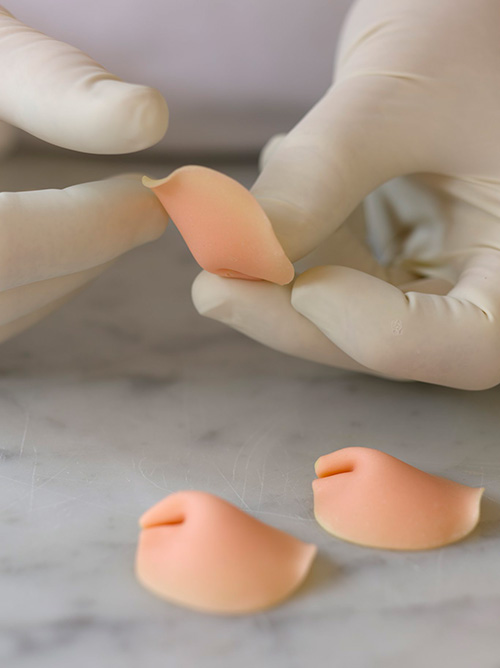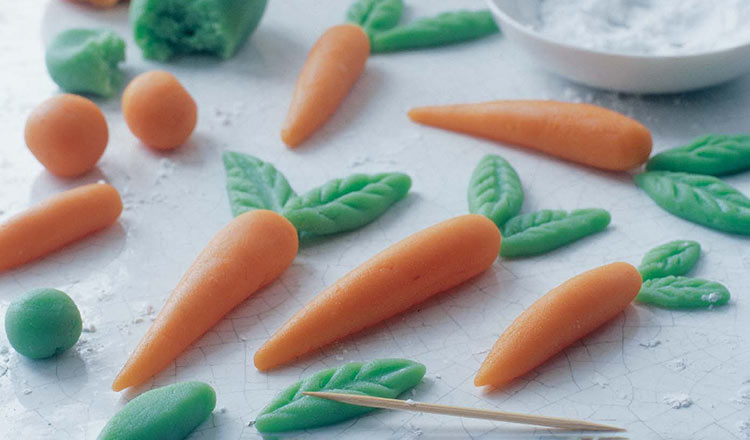In many parts of the world, sweet shops produce dazzling marzipan confections shaped and colored to look like fruit fresh from the tree and an array of other tempting shapes. Although the town of Lübeck in Germany is credited with making some of the best marzipans in the world, it is likely that this candy originated long ago in the Mediterranean, perhaps in parts of Italy where almonds were a mainstay of the diet, inspiring someone to invent this fragrant paste of almonds and sugar.
Kneading marzipan softens it and distributes any coloring you add. Once it is easy to work, you can roll the marzipan into sheets and cut out shapes. Or, roll marzipan by hand into small balls or cylinders to create three-dimensional candies or decorations. Fanciful fruit and vegetable shapes turn out best if you use a delicate touch with food coloring; vivid colors may look unnatural.
To make enough shapes to decorate a cake or other pastries from marzipan, you will need:
- One 7-oz tube or box marzipan
- Confectioners’ sugar, as needed
- Liquid or paste food coloring, as needed
- Vegetable oil, as needed
- Lightly beaten egg white, as needed
Gently knead or roll the marzipan, still in its packaging, on the counter a few times. Dust the work surface lightly with the confectioners’ sugar. Remove the marzipan from the package. To make more than one color, divide the marzipan into smaller pieces. Squeeze a few drops of food coloring onto the marzipan. Knead it by hand just until the color is evenly distributed and the marzipan is soft enough to roll out or mold into shapes. Keep any portion of the marzipan that you aren’t working with well covered to prevent drying.
To cover a cake, working on a surface lightly dusted with confectioners’ sugar, roll the marzipan into an evenly thin sheet about 1/16-inch thick. Turn the marzipan as you work to keep it from sticking and tearing. Cut to cover small cakes, or transfer the entire marzipan to the cake. Allow the sheet to drape over the sides and press them gently onto the sides of the cake. Pinch off any excess marzipan and rub the seams to seal and smooth them.
To make cutout shapes, dust your work surface and rolling pin lightly with confectioners’ sugar. Roll the marzipan into a very thin layer, about 1/8-inch thick. Use cutters of various shapes. Transfer the marzipan shapes to a plate and cover to keep them pliable.
To make flowers, use a flower-shaped cutter or a knife to create the petals. Roll a small ball of marzipan. With the handle of a wooden spoon, make a small depression in the center of the flower petals, and press the ball into the depression. To make fruit and vegetable shapes, roll the marzipan into a ball of the approximate size you’d like for the finished shape, then mold or sculpt as you would clay.
To make coffee beans, color the marzipan a deep brownish black. Break off small pieces and roll them into bean shapes. Press the blade of a paring knife lengthwise down the center of each bean.
Dip a toothpick into vegetable oil and use it to press any seams or depressions into the shape for a more natural look.
To attach smaller pieces, such as stems, centers, or leaves, use a toothpick to make a small depression at the point where you want to attach something, such as in the top of an apple shape. Use your fingertip to very lightly moisten the attachment (a small ball for the center of a flower, cutout leaves, longer cylinders for stems, for example) at the place where it should join the marzipan shape and press it gently in place. Use egg white to glue if necessary.


